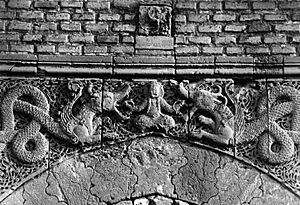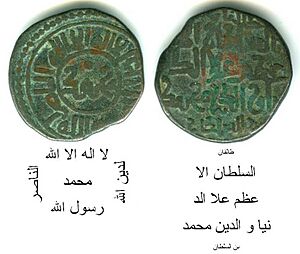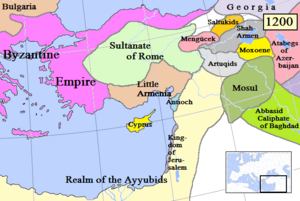- This page was last modified on 17 October 2025, at 10:18. Suggest an edit.
al-Nasir facts for kids
| al-Nāṣir li-Dīn Allāh الناصر لدين الله |
|
|---|---|
| Khalīfah Amir al-Mu'minin |
|

Possible depiction of Al-Nasir holding two dragons, which could be a symbol of his victory of his two major enemies: the Grand Master of the Assassins, and the Khwarizmian Empire ruler Muhammad II. Baghdad, Talisman Gate, built circa 1221-22.
|
|
| 34th Caliph of the Abbasid Caliphate Abbasid Caliph in Baghdad |
|
| Reign | 28 March 1180 – 5 October 1225 |
| Predecessor | al-Mustadi |
| Successor | al-Zahir |
| Born | 6 August 1158 Baghdad, Abbasid Caliphate |
| Died | 5 October 1225 (aged 67) Baghdad, Abbasid Caliphate |
| Consort |
|
| Issue |
|
| Dynasty | Abbasid |
| Father | al-Mustadi |
| Mother | Zumurrud |
| Religion | Sunni Islam |
Abū al-ʿAbbās Aḥmad ibn al-Hasan al-Mustaḍīʾ, known as al-Nāṣir li-Dīn Allāh (which means The One who Gives Victory to the Religion of God), was an important Abbasid caliph who ruled in Baghdad. He was born on August 6, 1158, and ruled from 1180 until his death on October 5, 1225.
Al-Nasir worked hard to bring back the power of the caliphate, which was like the main leader of the Islamic world. He was very successful, even conquering parts of Iran with his army. Some historians believe he was the last truly powerful Abbasid caliph.
Besides his military wins, al-Nasir also built many important buildings in Baghdad. One example is the Zumurrud Khatun Mosque and Mausoleum, which is still standing today.
Contents
Biography
Al-Nasir was the son of Caliph al-Mustadi and a Turkish mother named Zumurrud. His time as caliph was special because of the rise of groups called futuwwa. These were urban social groups in Baghdad that sometimes caused trouble.
Al-Nasir changed these groups. He reorganized them and used them to help his government. He gave them a new purpose, connecting them to Sufi ideas, which are about spiritual journeys in Islam.
In his early years, al-Nasir wanted to break the power of the Great Seljuq Empire. He encouraged the Khwarezm Shah, Ala ad-Din Tekish, to attack the Seljuq Sultan, Toghrul III. Tekish defeated Toghrul in 1194, and Toghrul was killed. After this victory, Tekish gave the caliph some parts of Persia that the Seljuqs used to control.
Al-Nasir's mother, Zumurrud, passed away in early 1203. She was buried in her own special tomb, known as the Zumurrud Khatun Mosque and Mausoleum.
Later, relations between al-Nasir and Tekish became difficult. The caliph even had one of Tekish's governors killed.
Tekish's son, Muhammad II, became angry with al-Nasir. He tried to weaken the caliph's religious authority. Muhammad II then planned to attack Baghdad. Some historians say that al-Nasir might have asked Genghis Khan, the powerful Mongol leader, for help against Muhammad. While this is debated, it's possible the caliph had some contact with the Mongols.
However, Genghis Khan soon became a threat himself. His armies swept across Central Asia, defeating the Khwarizm Shah, Muhammad II, who later died in exile.
Major Events and Policies
During al-Nasir's rule, several important political changes and events happened. He was often directly involved in these.
Weakening the Seljuqs
In 1186, a conflict started between Sultan Toghrul III and another leader named Qizil Arslan. This conflict weakened the Seljuq power. Al-Nasir supported Qizil Arslan, sending an army to help him.
In 1188, the caliph's army attacked Hamadan but was defeated. Despite this, Toghrul's army also suffered heavy losses. Toghrul then faced more problems, losing allies and making rash decisions.
Qizil Arslan, with the caliph's support, invaded Hamadan. Toghrul had to retreat. He tried to get help from others, even sending his young son to Baghdad, but it didn't work. Qizil Arslan eventually captured Toghrul in 1190 and imprisoned him.
Qizil Arslan then declared himself Sultan, encouraged by the caliph. However, he was poisoned in 1191. Toghrul was later freed in 1192.
Conflict with Khwarezm
After being freed, Toghrul quickly gathered an army and defeated his enemies near Qazvin in 1192. He took control of Hamadan and other areas. However, one of his opponents, Qutlugh Innach, asked the Khwarazmshah Ala ad-Din Tekish for help. Tekish invaded and captured Rey in 1192.
Toghrul tried to make peace with Tekish, agreeing to become his vassal. But Toghrul soon broke the truce. He attacked Rey in 1193, defeating Tekish's governor and taking back the city.
Al-Nasir, still wanting to weaken Toghrul, asked Tekish to move against him again. Toghrul defeated Qutlug Innach in battle, even though Khwarazmian troops were helping. However, Toghrul was finally defeated by Tekish in the Battle of Ray in 1194, with help from al-Nasir.

A coin minted in the name of Muhammad II (1200–1220) of Khwarezm, citing caliph al-Nasir as nominal suzerain.
Rejecting Khwarezmid Claims
By 1217, Muhammad II had built a huge empire. He declared himself "shah" (king) and wanted the caliph to officially recognize him.
However, Caliph al-Nasir refused. In response, Muhammad II gathered a large army and marched towards Baghdad to remove al-Nasir from power. But as his army crossed the Zagros Mountains, they were caught in a terrible snowstorm. Many soldiers died, and Muhammad's generals had to turn back. This saved Baghdad from invasion.
Death
Al-Nasir spent his last three years very ill, unable to move much and almost blind. He passed away on October 5, 1225, after suffering from an illness for twenty days.
His son, al-Zahir, became the next Abbasid caliph. Al-Zahir ruled for a short time, lowering taxes and building a strong army. He died in July 1226, and his son, al-Mustansir, became caliph after him.
See also
- al-Sarai Mosque
- Shihab al-Din 'Umar al-Suhrawardi designated as Shaykh al-Islam by al-Nasir.
- Baghdad School also known as the Arab school was an influential school of Islamic art developed during the late 12th century in the Abbasid capital Baghdad.
Sources
- Bosworth, C. E. (1968). "The Political and Dynastic History of the Iranian World (A.D. 1000–1217)". [Al-Nasir at Google Books The Cambridge History of Iran, Volume 5: The Saljuq and Mongol Periods]. Cambridge: Cambridge University Press. pp. 1–202. ISBN 0-521-06936-X. https://books.google.com/books?id=16yHq5v3QZAC&pg=PA1.
- This text is partly adapted from William Muir's public domain, The Caliphate: Its Rise, Decline, and Fall.
- Hartmann, Angelika. An-Nasir li-Din Allah: Politik, Religion und Kultur in der späten Abbasidenzeit.
|
Al-Nasir
Born: 6 August 1158 Died: 5 October 1225 |
||
| Sunni Islam titles | ||
|---|---|---|
| Preceded by al-Mustadi |
Caliph of Islam Abbasid Caliph 28 March 1180 – 5 October 1225 |
Succeeded by al-Zahir |



